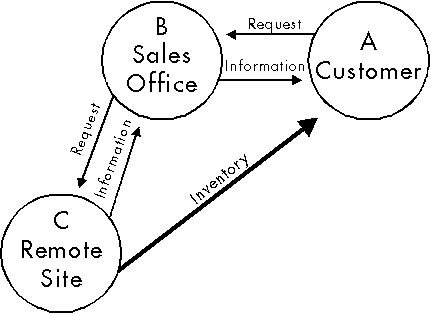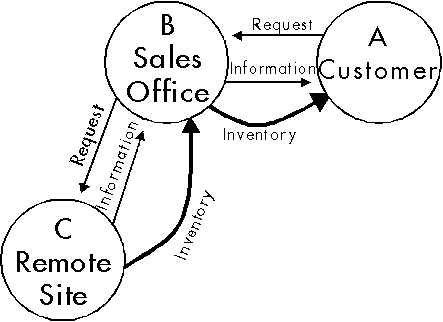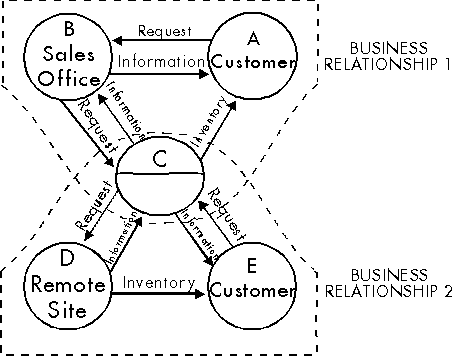Documentation >
MAC-PAC Reference Library >
Distribution >
Order Processing >
Key Concepts and Procedures >
Computer Integrated Distribution Overview >
Terminology
Terminology
Understanding the terminology is an integral part of understanding the computer integrated distribution process. It is important to be clear about the difference between transaction relationships and computer integrated distribution business relationships.
Each CID transaction has a "customer" and a "vendor" which can be any one of three business entities: a customer, a sales office, or a remote sourcing site. To better understand these relationships read the following definitions while referring to the figures below.
Transaction Relationships
Each CID transaction has two agents: an initiator and a recipient. In MAC-PAC, these agents are called "customers" and "vendors".
Customer
The customer is the entity that requests the transaction. It is also the entity that receives information or inventory.
Vendor
The vendor is the entity that responds to the request by supplying information or inventory to the customer.

Transaction Relationships
Business Relationships
Each transaction is done within the context of a business relationship. This business relationship must be clearly understood before the transaction's agents can be identified. A computer integrated distribution relationship consists of three entities: a customer, a sales office, and a remote sourcing site. Each entity can act as either agent (customer or vendor) of a computer integrated distribution transaction.
Customer
This entity initiates all CID processing and eventually receives the shipment of inventory. When involved in a transaction with the sales office, the customer is considered to be the "transaction customer". However, when involved in a transaction with the remote site (this only happens when goods are shipped directly from the remote site to the customer) the customer entity is referred to as the "end customer" or "direct distribution customer". The reason for this is that the "transaction customer" of the remote site is always the sales office that requested the goods; therefore, the location where the goods are to be shipped (the sales office's customer) is referred to as the direct distribution customer.
Sales Office
The sales office is the intermediary of most CID transactions. To the customer, the sales office is a vendor; to the remote site it is considered a customer.
Remote Site
Often the remote site is a warehouse belonging to or associated with the sales office. Consequently, the remote site deals primarily with the sales office to which it acts as a vendor. For the most part, the remote site will be invisible to the end customer because all dealings are routed through the sales office. The only exception to this is when the remote site is sending shipments directly to the end customer. In this case, because inventory is sent directly, the end customer considers the remote site as the supplying location of the sales office.

Computer Integrated Distribution Business Relationships (Using Direct Distribution)
The table below summarizes the CID business relationships shown above. From this chart you can see that each entity can be identified as a customer, sales office, or remote site depending on the business functions it performs.
|
|
|
Direct Distribution Customer of
|
|
|
A
(customer)
|
B
|
C
|
¾
|
|
B
(sales office)
|
C
|
¾
|
A
|
|
C
(remote site)
|
¾
|
¾
|
A, B
|
The Role of Computer Integrated Distribution Entities (Using Direct Distribution)
The same business relationship is shown below. The only difference is that this transaction does not use direct distribution.

Computer Integrated Distribution Business Relationships
(Not Using Direct Distribution)
The table below summarizes the CID business relationships shown above. From this chart you can see that each entity can still be identified as a customer, sales office, or remote site depending on the business functions it performs.
|
|
|
Direct Distribution Customer of
|
|
|
A
(customer)
|
B
|
¾
|
¾
|
|
B
(sales office)
|
C
|
¾
|
A
|
|
C
(remote site)
|
¾
|
¾
|
B
|
The Role of Computer Integrated Distribution Entities (Not Using Direct
Distribution)
It is also important to remember that each site can perform more than one business function. The figure below shows how entity C acts as the remote site in the first business relationship and as the sales office in the second business relationship.

Multiple Business Relationships
The table below summarizes the role of entity C in the computer integrated distribution business relationships shown above.
|
|
|
Direct Distribution Customer of
|
|
|
A
(customer)
|
B
|
C
|
¾
|
|
B
(sales office)
|
C
|
¾
|
A
|
|
C
|
D
|
¾
|
A, B, E
|
|
D
(remote site)
|
¾
|
¾
|
C, E
|
|
E
(customer)
|
C
|
D
|
¾
|
The Role of Entity C